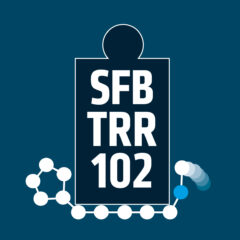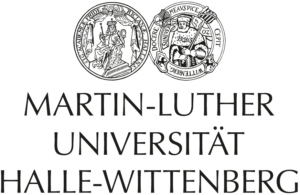Torsten John on “Impact of nanoparticles on amyloid peptide and protein aggregation”
and
Susanne Weininger on “UV-B induzierte Modifikationen am hγD Linsenkristallin”
Location: Martin-Luther-Universität Halle-Wittenberg Von-Danckelmann-Platz 3, SR 1.03 06120 Halle (Saale) Time: 3.30pm - 5.00pm Link to OpenStreetMap
Abstracts
Impact of nanoparticles on amyloid peptide and protein aggregation
Torsten John
The aggregation of amyloidogenic peptides into fibrils is relevant for many organisms. While they are natively water-soluble, they can form fibril aggregates under certain conditions. Amyloidogenic peptides are associated with several age-related diseases, such as Alzheimer’s disease or type II diabetes. Knowledge on the aggregation mechanism and a detailed characterisation of the transient species is essential to understand the physiological role of these peptides. [1]
Interfaces, such as nanoparticles, can act to accelerate or inhibit peptide aggregation. Experimental studies and molecular dynamics simulations (MD) were used to study the accelerating and inhibiting effects of nanoparticles on the fibril formation process. [2–4] The role of gold surfaces in oligomer formation and peptide aggregation is discussed in this study. Moreover, possible mechanisms for the observed acceleration of the peptide aggregation by a reduction of the conformational space are presented.
[1] F. Chiti, C. M. Dobson, Annu. Rev. Biochem. 2017, 86, 27–68.
[2] A. Gladytz, B. Abel, H. J. Risselada, Angew. Chemie – Int. Ed. 2016, 55, 11242–11246.
[3] A. Gladytz, M. Wagner, T. Häupl, C. Elsner, B. Abel, Part. Part. Syst. Charact. 2015, 32, 573–582.
[4] T. John, A. Gladytz, C. Kubeil, L. L. Martin, H. J. Risselada, B. Abel, Nanoscale 2018, 10, 20894–20913.
UV-B induzierte Modifikationen am hγD Linsenkristallin
Susanne Weininger (rehearsal)
Katarakt, die Trübung der Augenlinse, ist die Hauptursache von Blindheit weltweit. Mehr als 50% aller Erblindungen sind darauf zurückzuführen [1], wobei sich die Krankheit hauptsächlich im Laufe des Lebens durch eine komplexe Wechselwirkung zwischen genetischen und umweltbedingten Risikofaktoren ausbildet [2]. Umweltbedingte Risikofaktoren beinhalten u.a. Rauchen, Fettleibigkeit, erhöhte Glukosewerte im Blut, übermäßigen Alkoholkonsum und UV – Bestrahlung [3]. Laut unterschiedlichen Abschätzungen sind dabei 10 – 20% der weltweit bekannten Blindheitsfälle auf die UV – B Bestrahlung zurückzuführen [4, 5]. Um den Entstehungsmechanismus von Katarakt besser zu verstehen, wurden daher NMR spektroskopische Untersuchungen auf atomarer Ebene an dem humanen Linsenprotein hγD vor und nach Bestrahlung durchgeführt und ein zusätzlicher, stabiler UV – B induzierter Zustand B identifiziert und charakterisiert.
[1] Pascolini, D. and S.P. Mariotti, Global estimates of visual impairment: 2010. Br J Ophthalmol. 96(5): p. 614-8.
[2] Shiels, A., T.M. Bennett, and J.F. Hejtmancik, Cat-Map: putting cataract on the map. Mol Vis. 16: p. 2007-15.
[3] Hejtmancik, J.F. and M. Kantorow, Molecular genetics of age-related cataract. Exp Eye Res, 2004. 79(1): p. 3-9.
[4] WHO, The Effects of Solar UV Radiation on the Eye. Programme for the Prevention of Blindness – Office of Global and Integrated Environmental Health, 1993.
[5] Sliney, D.H., UV radiation ocular exposure dosimetry. J Photochem Photobiol B, 1995. 31(1-2): p. 69-77.





One thought on “Doctoral students seminar (June 24, 2019)”